Landscape Painting (American Tradition)
 From Nwe
From Nwe 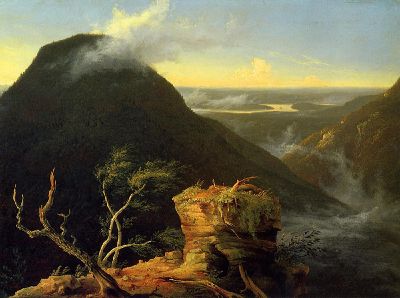
Landscape Painting in the American tradition, depicts the scenery of the natural world with the views that impact the artist's eye. In an effort to represent the beauty that meets the eye, the artist tries to capture that fleeting moment in time and space, for all time, thus becoming a co-creator along with the original Creator.
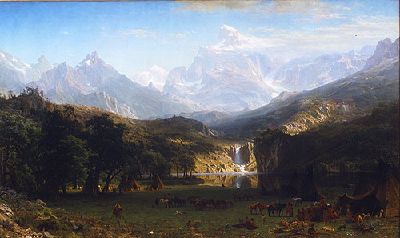
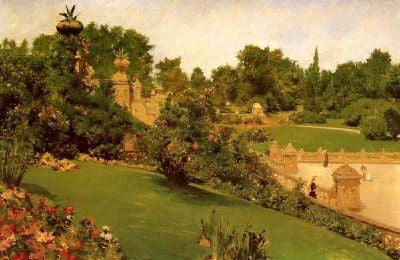
The American landscape
In The Beginning, All the World was America - John Locke
In the woods, is perpetual Youth. The currents of the Universal Being circulate through me; I am part or particle of God. - Ralph Waldo Emerson. Nature
Young America
In America the young nation began with its influences chiefly from England and the European tradition. Gradually, over time as if molded by the landscape itself, uniquely American genres and styles were born with more than an occasional nod back over the ocean.
The thoroughly American branch of painting, based upon the facts and tastes of the country and people is ... landscape James Jackson Jarves in his book The Art-idea, 1864.
In 1816 De Witt Clinton soon to be Governor of the State New York, declared, "Can there be a country in the world better calculated, than ours, to exalt the imagination?"
Images of the landscape and ideas of the nation were deeply intertwined. These played an important role in shaping American identity in the nineteenth century. Indeed the vast panoramas from east to west cried out for painters and slowly they made their way into this new paradise.
The Hudson Valley Painters
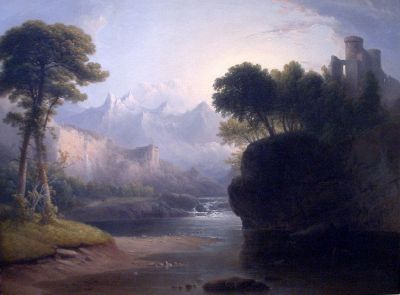
Many of the landscapes produced in the eighteenth century were strictly topographical; views of towns or beauty spots and were often made by military men. In the early decades of the nineteenth, landscape began to be created as pure and ideal.
Thomas Doughty, (1793-1852), from Philadelphia began with picturesque composition, while History painter Washington Allston, Diana On a Chase 1805, trained in London, with his allegorical scenes rooted in the Italian tradition and naturalized by the English, gave stimuli to Thomas Cole's ambitious program to create a uniquely American landscape art. It was to find examples of the sublime and picturesque; that were featured in the writings of Washington Irving, set in the Catskills, The Legend of Sleepy Hollow and Rip Van Winkle, 1890-1920, and James Fennimore Cooper's 'Leather Stocking' novels such as The Last Of the Mohicans (1826) that started Thomas Cole and other artists after him, to make their way to the Catskill mountains, in the Hudson Valley, only a short distance up the Hudson River from New York City. Kindred Spirits 1849, (oil on canvas), by Asher Brown Durand depicts the poet Willim Cullen Bryant and painter admiring the Catskill scenic panorama. These are men 'who in the love of Nature holds Communion with her visible forms' Thanatopis.
The English landscape painter John Martin's outsize works, (1851-1853) three apocalyptic visions in vast landscapes seen in Romantic mezzotints, were to influence both Thomas Cole and Asher Durand.
Thomas Cole, born in England, moved with his family to Ohio but he returned to the East Coast to work as a landscape painter, inspired by Washington Allston, to include poetic themes. He articulated his ideas both in words as in paint. In 1829 he returned to Europe and England where he saw J.M.W. Turner's work. He was interested in his ideas of the Sublime (drama in nature) in the language of the landscape.
Cole's early works have an air of improvisation, violent dramas of chiaroscuro, although his need to make known the beauties of the American scenery made everything he did seem fresh and new, as in Mountain Sunrise, Catskill 1826, (oil on panel). From 1833 through 1836 he worked on The Course of Empire a series of modest paintings, for a New York patron, as an allegory on the progress of civilization. These held a wide range of technical experiment and a potted history of different landscape styles.
A close contemporary, Jasper Francis Cropsey, (1823-1900), adopted Cole's methods and made them his own. Autumn on the Hudson River, 1860, (oil on canvas), was to be the central masterpiece of what was to be loosely termed as The Hudson River School in the 1870s. This term, derisively coined by a critic on the New York Tribune art critic Clarence Cook or the landscape painter Homer D. Martin (Howat, pages 3-4) included Frederic Edwin Church, John Frederick Kensett, Robert Swain Gifford and Asher Durand.
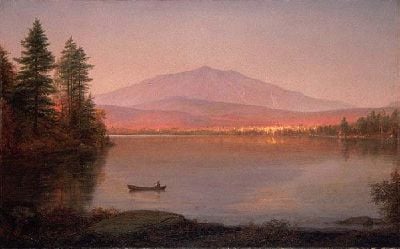
Frederic Church came from a wealthy family in Connecticut, and joined Cole in his Catskill, New York studio in 1844. Church acknowledged Cole's mastery and apprenticed himself to Cole for two years. Church's early work echoed his master's. After Cole's death, Church changed his style dramatically and produced work that simplified the view and created a poetry from just a few simple elements as in, Clouds at Sunrise, 1849. John Frederick Kensett painted with much cooler colors, Reminiscence of the White Mountains 1852, (oil on canvas), was a contrast to the warmth of the previous artists' subjects. His serenity and lack of busy brushwork was later to be given a name, Luminism in the 1950s by an art-historian and was applied equally to such artists as Martin Johnson Heade, (1819–1904) and Fitz Hugh Lane, (1804–1865), a great painter of ships as in Becalmed off Halfway Rock, 1860, (oil on canvas). The Hudson River School]] artists were not a group and with limited exception did not work together. Sanford Robinson Gifford was a master of a radiant and diffused sunlight in, The Wilderness, 1860, (oil on canvas) and Heade created dramatic scenes as in, Thunderstorm At the Shore, 1870-1871, (oil on paper, on canvas mounted on wood panel).
George Innes, the same age as Frederick Church, belonged to both the National Academy of Design like Church and the Society of American Artists. He traveled widely. In 1840 he came to know the Barbizon School in France and admired Jean-Baptiste-Camille Corot's work, plein-air. He followed this practice of making sketches on site and then finishing the painting in the studio, allowing his imagination free rein which gave his scenes a silent dusky look as in Sunset at Montclair, 1894, (oil on panel).
Some persons suppose that landscape has no power of communicating human sentiment. But this is a great mistake said George Innes.
Another member of the Society, Albert Pinkham Ryder, inverted the landscape further. He was a painter of the mysteries and moods of the night and the sea, and created works of inner expression with little or no outline such as Moonlit Cove, 1880-1890, (oil on canvas). Typically, it is a work described as Expressionist.
Frederick Edwin Church's purpose in painting landscapes was found in showing the public the paradise of the New World. To this end he evoked Claude Lorrain's style of composition but made enormous canvases that were put on show, for which he charged, at eye level for people to see his paintings, similar to J.M.W. Turner's idea (in London) of giving the viewer a more complete experience.
Church was an explorer. He journeyed to South America for exotic views, as in the Andes of Ecuador 1855. After an extended trip to the Middle East. He returned to the United States and purchased a tract of land across the Hudson River from Catskill, New York and built a home modeled after Middle eastern structures and called it Olana. His new home was an amber windowed castle of a house, with a commanding view overlooking the Hudson River, opposite the Catskill Mountains, decorated with ceramic tiles from Turkey in a blend of Gothic, Persian and Aesthetic Movement elements, it stands today, a symbolic shrine to the spiritual and poetic artists in the nineteenth century.
Twilight in the Wilderness, 1860, (oil on canvas), symbolized the mood of America, at that time, an emblem of Transcendentalism. In his repertoire of unique but spectacular panoramas were, Niagara Falls from the American Side, 1867, Icebergs, and the Aurora Borealis, all (oil on canvas).
Coming of Age
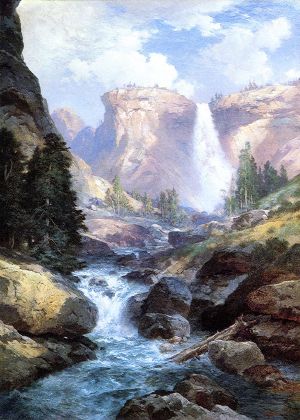
Church's greatest rival was Albert Bierstadt, with his sensational paintings of the American West. Born In Germany in 1830 and with his family, moved to America at age two and later returned to Dusseldorf to study painting. On return in 1859, he went on an expedition the explore the Rocky Mountains. The great picture that he made on his return was The Rocky Mountain, Lander's Peak, 1863, (oil on linen). His style was cool, objective and very detailed and had already been proved by a Swiss painting of Lake Lucerne. His technique was to make pencil sketches and small oil studies. His brothers ran a photographic studio and he also used a camera. His work was known as new Ideal landscape painting, especially depicted in Among the Sierra Mountains, California shown in London in 1868, "not fiction but portraiture," was the reaction. Sunset in the Yosemite Valley, 1868, (oil on canvas), was described by the artist as the Garden of Eden, 'the most magnificent place I was in,' recalling Thomas Cole's Expulsion from the Garden of Eden, 1827-1828, (oil on canvas). As a result of paintings from this area, in 1864, during the American Civil War, landscape architect, Frederick Law Olmsted (creator of Central Park, in New York City) drafted a bill for the preservation of Yosemite Valley, for the nation which President Abraham Lincoln signed into law.
Thomas Moran, (1837-1926) born in England as Cole was, grew up in Philadelphia and in 1860 traveled to Lake Superior. From this trip he gathered material for his Hiawatha pictures. After producing a series of bright watercolors of Yellowstone National Park's geysers and springs, a law was passed protecting that land from development and his painting Grand Canyon of the Yellowstone and The Chasm of the Colorado (1892) (oil on canvas). Both massive paintings were purchased by the United States Congress. This marked the end of the panoramic tradition of the American Sublime.
A New Century, New Ideas
Winslow Homer another great painter began as an illustrator in Boston and served as an artist during the Civil War, he was famous foe wood engravings and soon his oils and watercolors became as popular. He travelled extensively and saw Japanese prints in France and took the best ideas of the west and the east and made them his own. He described the physical phenomena of the sea with spontaneity in both watercolor and oil. His West Point, Prout's Neck, 1900 (oil on canvas) combined these elements of style, a new vision for a new century.
From the 1890s through the 1910s, American Impressionism flourished in art colonies, loosely affiliated groups of artists who lived and worked together and shared a common aesthetic vision. Art colonies tended to form in small towns that provided affordable living, abundant scenery for painting, and relatively easy access to large cities where artists could sell their work. Some of the most important American Impressionist artists gathered at Cos Cob and Old Lyme, Connecticut, both on Long Island Sound; New Hope, Pennsylvania, on the Delaware River; and Brown County, Indiana. American impressionist artists also thrived in California at Carmel and Laguna Beach; in New York on eastern Long Island at Shinnecock, largely due to the influence of William Merritt Chase; and in Boston where Edmund Charles Tarbell and Frank Weston Benson became important practitioners of the impressionist style.
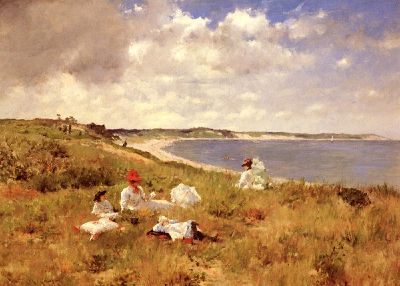
Ten American Painters or The American Ten or The Ten A group of American painters from New York and Boston who exhibited together from 1898-1919. They had been members of the Society of American Artists, but resigned from this organization upon deciding that its exhibitions were too too large and conservative. Most of the Ten had studied in Paris in the 1880s and were greatly influenced by French Impressionism. The Ten were: Thomas E. Dewing (1851-1938), Edward E. Simmons (1852-1931), Julien Alden Weir (1852-1919), John Henry Twachtman (1853-1902), Joseph R. De Camp (1858-1923), Willard L. Metcalf (1858-1925), Childe Hassam (1859-1935), Frank Benson (1862-1951), Robert Reid (1862-1929), and Edmund C. Tarbell (1862-1938). William Merritt Chase (1849-1916) took Twachtman's place among "The Ten" when Twatchman died.
Childe Hassam, former illustrator, embraced Impressionism and gave New York City a softer and more poetical atmosphere in his painings there and has been called the Sisley of Madison Ave, as in Late Aftermnoon, Winter, New York, 1900 (oil on canvas. In summer, he forsook the city for New England where he was fond of painting women and flowers but in Southwest Wind, 1905 (oil on canvas) achieved a real feeling of movement and life. The most lyrical exponent of American Impressionism was John Henry Twatchman. A large painting in France, Arques-la-Bataille, 1885 (oil on canvas) shows the influence both of James Whistler and Japanese art and is almost mono chromatic. After returning to America he bought a farmhouse in Connecticut and with friends created a small colony, painting scene after scene there. After exploring every medium available he took his creative powers to their limits. His landscapes were of the mind and of the heart rather than of the world.
Ohio-born Charles Burchfield was one of the great artistic visionaries of the twentieth century. Inspired by Leon Bakts' designs for ballet and Chinese scroll painting and after moving from Ohio to Buffalo, New York, from 1915-1921 he produced a unique body of work. In 1963 he stated, "An artist must paint, not what he sees in nature, but what is there. To do so he must invent symbols..." Decorative Landscape, Hot Morning Sunlight (Posts' Woods) (water color on paper) started in pencil and colored later. His is the first great painting of our heartland. With a career that spanned half-a-century, he never became abstract and regarded painting as a moral and spiritual act. These unusual paintings of nature, seem to be giving off vibrations from the trees, flowers, and plants.
Edward Hopper stayed away from abstraction too and as a student in 1900 at the New York School of Art, traveled to Europe and later worked as a commercial artist in the City. He first showed with etchings and later oils. The Camel's Hump 1931 (oil on canvas) exemplified his idea that, "My aim in painting has always been the most exact transcription possible of my most intimate expressions of nature." Hopper is the starting point for the later, Realists.
Maxfield Parrish as an illustrator was in great demand and his landscapes looked magical, idealistic and theatrical and many were invented from models. However, he really wanted to concentrate on painting landscapes and at age 64 began a series of paintings for Brown and Bigelow, greeting card publishers. In 1934, he painted Elm, Late Afternoon paving the way for a relationship which lasted for 30 years, through ill health and arthritis and he stopped at 91, passing away in 1966, a career of, 75 years. His Daybreak first reproduced in 1923, remains one of the most beloved images of all time and made him a princely sum for his day.
The first Moderns
Marsden Hartley was one of the first great modern painters, although an itinerant, constantly struggling with his personal life and finances and unable to settle, he alternated between Nova Scotia, Maine, New England and New York. His paintings of The Last Stone Walls, Dogtown (Gloucester, Mass.) 1936-1937, oil on canvas, reminiscent of Pynkham Ryder, point the way to future modernism.
Charles Sheeler, born 1883, studied with William Merritt Chase at the Pennsylvania Academy of the Fine Arts as did other great painters of the period. He later worked as an architectural photographer to supplement his painting and used photographs as source material for paintings and drawings throughout his career. In 1937 he wrote, "Photography is nature seen from the eyes outward, painting from the eyes inward." View of Central Park 1932 (conte crayon) based on a photograph and took on the quality of a photo, a taste of what would become Photo-Realism 30 years later.
Regionalism, the Mid-West and South-West
Grant Wood's Fall Plowing 1931 Oil on canvas, at a time of great financial depression shows an ideal mid-western agrarianism. Grant Wood, Thomas Hart Benton and John Steuart Curry are considered the trinity of Regionalism, an anti-dote to modern art. Wood had studied Flemish art and was highly stylized but Alexandre Hogue made stronger comments on the abuse and exploitation of the land with his The Crucified Land 1939 (oil on canvas), and paintings of the Dust Bowl.
Georgia O'Keeffe who'd made her mark in New York City with her city-scapes, close-up flower paintings, moved to New Mexico permanently, after her husband, photographer, Alfred Stieglitz's death in 1946. Moving between abstraction and realism she portrayed the Southwest and the desert with sensuality and ambiguity as in Black Place 11 (oil on canvas).
Cape Cod
Milton Avery, with the intensity of Georgia O'Keeffe and mainly self-taught he painted almost abstract, sweet natured views of the New England coast. His reductive style, from small sketches to water colors to oils, led to free and lyrical poems of nature, vis a vis, Tangerine Moon and Wine Dark Sea, 1959, Oil on canvas. His work led to the pure abstract fields of color painted by his friend, Mark Rothko.
Edwin Dickinson, Rock Edge Palisades, 1953 (oil on canvas), was another artist whose tone poems seem to belong both to the 1980s and to the 1880s both. He was a master of tonality and delicate chromatic shifts, who'd studied as had O'Keeffe, with William Merritt Chase but belonged to no one group and produced some of the most dream-like images of the twentieth century.
Towards Realism and a new Realism
Andrew Wyeth for all the argument about his work is indeed a painter of significance and realism. While the son of the well known illustrator N. C. Wyeth and in the tradition of Howard Pyle and Albrecht Durer, he is a superb draftsman and master craftsman. At first his work was thought of as photographic, but with the advent of Photorealism (in the 1970s), it was realized just how interpretive he was. Ring Road, 1985, (tempera), reveals an Oriental feeling and abstraction. However, his work is always painterly and tactile. His son, painter James Wyeth, continued the family tradition into the present day in what is termed the Brandywine Heritage named from the studios created by Pyle and N. C. Wyeth near the Brandywine River at Chadds Forge, Pennsylvania.
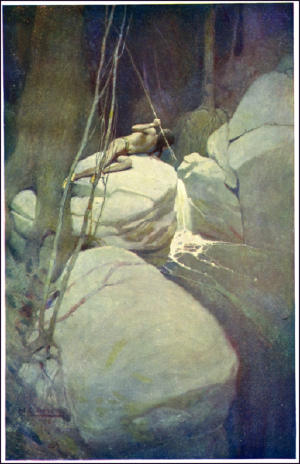
- Fifties and sixties
In the mid-1950s and 1960s came a shift from abstract to figurative painting on both the East and West coasts. In California, the influences included Henri Matisse and Richard Diebenkorn, View From a Porch (oil on canvas) 1959, Wayne Thiebaud, Coloma Ridge, 1967-1968 (acrylic and pastel on canvas), David Park, Elmer Bischoff, Landscape Afternoon 1959 (oil on canvas). Paul Wonner, James Weeks and Theophilus Brown, West Coast realists from the 1950s, in the late 1960s, became known as the Bay Area figurative painters. In the East, the Abstract Expressionists had held sway but that began to change in the late 1960s. Fairfield Porter's beautiful Island Farmhouse, 1969 (oil on canvas) was claimed by the artist to be 'reformed Realism'. Others artists included Phillip Pearlstein, who later became a painter of realistic nudes, is well known for his Monument Valley a 1976 watercolor. Gabriel Laderman, came to realism from abstract and is known for his intellectual, cool style, as seen in his West Dover, 1968 (oil on canvas). Neil Welliver is a widely known painter and is known for his large paintings of the wilds of northern Maine, such as Late Squall, a 1984 (oil on canvas). Alex Katz well known for his slick portraits has produced a large number of landscapes, since the 1950s, often using a collage motif. Full Moon, 1987 (oil on canvas) is a noted exception.
Painterly Realism, Romantics and Expressionists
Artists such as James Weeks, Berkshire Landscape, 1972-1973 (acrylic on canvas), developed from Abstract Expressionism and were known as 'painterly'. The Bay Area Figurative Movement artists never lost their painterly traits developed since the 1950s. Others include Jane Freilicher, Thicket and Field 1984 (oil on canvas); Paul Reiska, Horseleech Pond, Indian Red Sky, 1984 (oil on canvas); Vincent Arcilesi, Grand Canyon, 1975 (oil on canvas); George Nick Over Pemigewasset River 1986 (oil on canvas); Richard Crozier, Owlshead from Mount Battie 1986 (oil on canvas); and the plein-air premier-coup paintings of Nebraska by Keith Jacobshagen such as N.W. 84th St. & Agnew Rd 1983 (oil on paper). Others include, from the 1980s, Don Nice, Sheila Gardner, Susan Shatter, John Gordon, and William Nichols.
Representative of those painters that render the precise image are, Rackstraw Downes with his, Dragon Cement Plant, Maine, 1986 (oil on canvas) and Richard Estes whose work from photographs, but without mechanical aids, is known as a Photo-Realist, as seen in his painting Central Park, 1987 (oil on canvas). William Beckman, Marjorie Portnow, Altoon Sultan, Ben Burns and many others from the 1980s worked in this strict realistic style, whether working from photographs or not.
The Romantics however were more instinctive in approach, as in Jack Beale's Dark Pool 1980, (pastel on paper). Russell Chatham, Winter Evening, 1980 (oil on canvas), and Robert Jordan, The Trail to Champney Falls, 1981 (oil on canvas) are also considered as atmospheric as are Richard Chiriani, David Ligare, Bonnie Sklarski, who with Juan Gonzalez added allegory to the mix. Paul Wonner's Twenty-seven Studies for Romantic Views of San Francisco 1980 (acrylic on paper) are considered to be numbered among the Romantics of the 1980s.
Bernard Chanet, Changing, 1986 (oil on canvas) is one of those landscapes that has carried forward the great Expressionist art of past eras. Alfred Leslie with Approaching the Grand Canyon, 1977-1981, a series of five watercolors from 100 Views Along the Road reveal the spirit of the landscape painting. Wolf Kahn 's Barn Atop a Ridge, 1987 (oil on canvas) expressed Kahn's statement that he wanted to, "do Rothko over again from nature." Kahns oils and pastels, seem to shimmer in fields of color. Neil Blaine, Gloucester Harbor from Banner Hill, 1986 (oil) and many more works display these highly expressive styles.
The rebirth of impressionism in America: The 1950s and beyond
In the 1950s, a quarter of a century after the death of Claude Monet, major museums in America started having exhibitions of the original French Impressionists paintings, and in so doing Impressionism was reborn. The resurgence of interest in Impressionism continues to this day, and is especially evident in the continued popularity of En plein air painting.
Tradition continues
In the Hudson Valley region today are many painters continuing the tradition of those pioneers of the past. Among them are two artists who have taught at the State University of New York at New Paltz, in the Fine Arts program. This college sits in view of the beautiful Shawgunk Mountain ridge. Its famous Mountain House is a favorite of international climbers, at the beginning of the Catskill mountain chain.
These views inspired Alex Martin, with his studies in oil and watercolors and other media, of the effects that light and local skies have on the scenes in the valleys and on the mountains. His paintings are full of gesture and reflect the colors and hues of earlier Impressionists and Abstract Impressionists, as in Soft Landscape (oil on canvas) collection of the artist.
Another former lecturer, George Wexler, who had real experience as a New York City, Abstract Impressionist, traveled further afield to find his subject matter. Finding accessible views all over the Hudson River Valley area, he painted, in oils, in a much more realistic, almost photo-realistic, manner, as in View from Mohonk Farm (oil on canvas) collection of Metropolitan Life, New York City. He readily admitted that, "it's impossible to paint every leaf, so that realism is really a mis-nomer." Both artists, Wexler and Martin prefer to paint plein air and finish work in the studio.
In the twenty-first century, painters continue to reveal the American landscape, rural and urban in every style and medium available in this great time of technical innovation. There are still those who stay with the true and tried method of plein air and or working from sketches, water colors, pastels, and other media and remain in the studio. One California artist is, Dory Grade, who at more than 70-year-old continues to work from nature in this ageless method. She has taught on a regular basis. A long time resident of Eagle Rock, she is mentioned in the same breath as other celebrities who've made their home there. Extremely versatile, she is equally comfortable with drawing, oil paint, watercolor, acrylic, silkscreen, etching or lithographic printmaking. Her work is defined, not by a style, but rather by continual experimentation, growth and change. The only constant is her focus on the natural world. Dory Grade stated:
"My 30 years of art shows in Boddy House Gallery is my contribution to renewal of the Human Spirit, surrounded by nature.
Art is not created, it is achieved.
It is the product of talent and relentless practice, tempered by years of training.
But even then, you give more.You give your soul."
The Inner Landscape
Other artists who work with an abstract or surrealistic style to explore the inner landscapes of ourselves and our imagination, include Jan Parker in Hawaii and Benny Andersson in New Jersey.
Benny Andersson paints "visual prayers, intended to promote deep reflection and healing within the viewer and to have a spiritual and uplifting effect on the soul, to keep dreams alive." He views artists as "messengers of truth and beauty." His landscapes, full of unique imagery, cosmic and earthly visions, recall Hieronymus Bosch and are endowed with transparent colors as clear as glass. Unlike Hieronymus Bosch, his art shows worlds free from danger, impurity, and abuse. Andersson allows the viewer to see nature innocently. Originally from Sweden, he has lived and worked in the United States for more than thirty years, exhibiting in several countries, including Japan. His titles give clues to their content as in Rites of Eternal Harmony (acrylic on canvas) and The Great Beyond, (acrylic on canvas). In Cheongpyeong, South Korea, he was commissioned to create two large paintings for a newly built palace there. The subjects were God's Ideal in the Spirit World and God's Ideal World on Earth, 2005-2006.
Jan Parker is an British artist also working in the United States for thirty years and now a resident of Hawaii, He now works in a purely abstract style reminiscent of the Abstract Impressionists, such as Mark Rothko. He does this with a concentration of fields of light and color brightly interacting together and has had great success in Japan with his new series, Portrait of God and Color of God. The Heart of God series by Parker is expected in Spring, 2008. Following a serious illness he said, "the overwhelming existence that saved my life is indescribable in words, it could only be described in painting."
Through his wife, Sawako, who previously had bought one of his paintings following a deep experience from it, he found the support needed to make a leap of faith into a new experience of painting. His impasto style reflects his feeling that, "painting ought to look like it has been painted" and convey the sense of the vibrations transmitted by the Divine. Parker said, "To me God is the greatest artist of all. A red field of fire and passion with a high horizon of pinks and yellow and a sliver of blue, is entitled God is King Of Kings, 2005 (acrylic on canvas). While the cover of the Color of God series dances across the book in vibrant waves of many colors and hues, from Color of God No 14, The Heart of God series was first viewed in Spring, 2006 (oil). "These paintings have been inspired by the essence of true love that I have experienced in nature," he wrote.
Gallery
-

The Great Horseshoe Fall, Niagara by Alvan Fischer, 1820
-

Gilpin's Mill on the Brandywine, by Thomas Doughty, circa 1827
-

View Near the Village of Catskill, by Thomas Cole, 1827
-

In the Catskills, by Thomas Cole, 1837
-

Autumn—On the Hudson River (Cropsey, 1860)
-

Twilight in the Wilderness, by Frederic Edwin Church, 1860
-

The Rocky Mountains, Lander's Peak by Albert Bierstadt, 1863
-

Lake Tahoe, by Albert Bierstadt, 1868
-
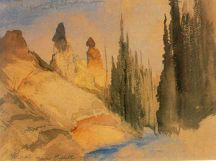
Tower Creek, Thomas Moran, 1871
-

Fisherman's House, Greenwood Lake (New Jersey), by Jasper Francis Cropsey, 1877
-
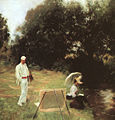
Dennis Miller Bunker Painting at Calcot, by John Singer Sargent, 1888
-

Summer Landscape by George Inness, 1894
-
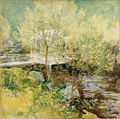
The White Bridge by John Henry Twachtman, 1895
-

Shinnecock Hills, Long Island, by William Merritt Chase, 1895
-
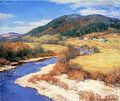
Indian Summer, Vermont by Willard Leroy Metcalf, 1909
-
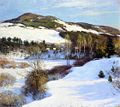
Cornish Hills, by Willard Leroy Metcalf, 1911
References
ISBN links support NWE through referral fees
- Arthur, John. Spirit of Place, Contemporary Landscape Painting & The American tradition. Bullfinch Press, 1989. ISBN 0821217070
- Bazarov, Konstantin. Landscape painting. London: Octopus Books; New York: Mayflower Books, 1981. ISBN 978-0706412307
- Clark, Sir Kenneth. Landscape into Art. Harper and Row, 1949. ISBN 0060107812
- Jeffares, Bo. Landscape Painting. New York: Mayflower Books Inc., 1979. ISBN 0831754133
- Leonard, Elizabeth. Painting the Landscape, Watson-Guptill Publications, 1984. ISBN 0823036553
- McShine, Kynaston (ed.). The Natural Paradise, Painting in America 1800-1950. New York: The Museum of Modern Art, 1976. ISBN 0870705059
- Novak, Barbara. Nature and culture: American landscape and painting, 1825-1875. New York: Oxford University Press, 1980. ISBN 0195026063
- Shanes, Eric. Turner The Masterwoks. Portland House, 1990. ISBN 0517015099
- Wilton, Andrew, T.J. Barringer, and Tate Britain (Gallery). American sublime: landscape painting in the United States, 1820-1880. Princeton, NJ: Princeton University Press, 2002. ISBN 0691096708
- Wilton, Andrew, and Tim Barringer. American Sublime, Landscape Painting in the United States, 1820-1880. Princeton University Press, 2002. ISBN 0691096708
Credits
New World Encyclopedia writers and editors rewrote and completed the Wikipedia article in accordance with New World Encyclopedia standards. This article abides by terms of the Creative Commons CC-by-sa 3.0 License (CC-by-sa), which may be used and disseminated with proper attribution. Credit is due under the terms of this license that can reference both the New World Encyclopedia contributors and the selfless volunteer contributors of the Wikimedia Foundation. To cite this article click here for a list of acceptable citing formats.The history of earlier contributions by wikipedians is accessible to researchers here:
- Landscape painting (American tradition) history
The history of this article since it was imported to New World Encyclopedia:
- History of "Landscape painting (American tradition)"
Note: Some restrictions may apply to use of individual images which are separately licensed.
↧ Download as ZWI file | Last modified: 02/04/2023 00:53:08 | 109 views
☰ Source: https://www.newworldencyclopedia.org/entry/Landscape_painting_(American_tradition) | License: CC BY-SA 3.0
 ZWI signed:
ZWI signed: KSF
KSF